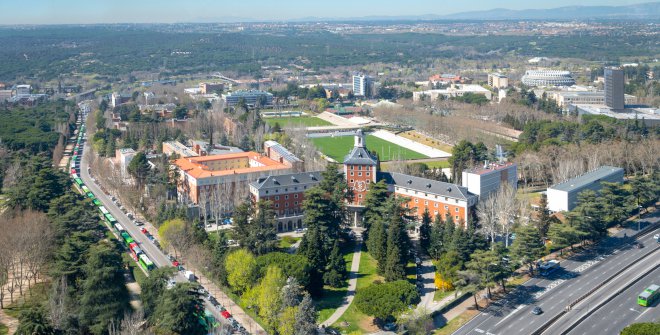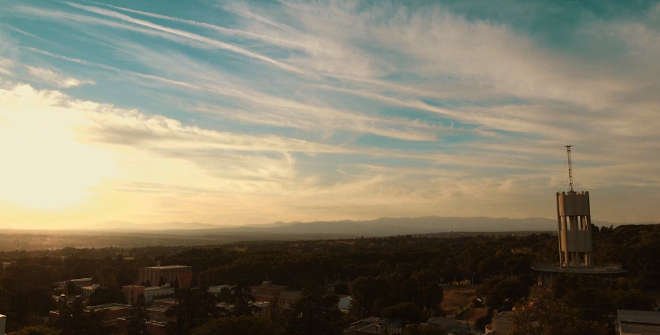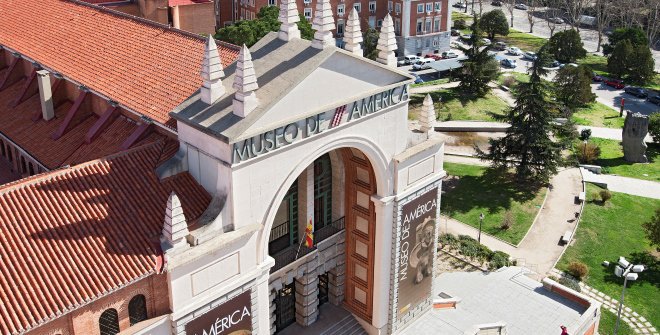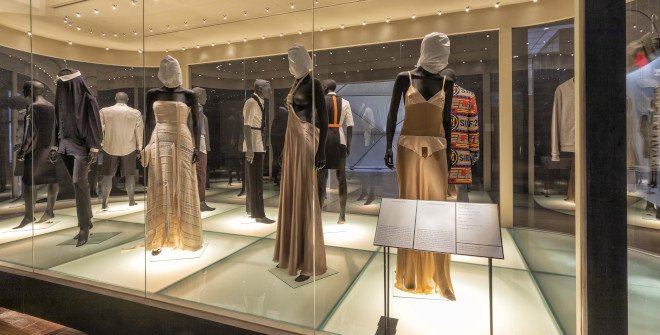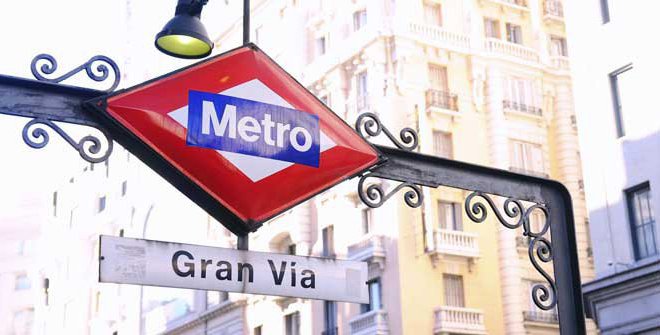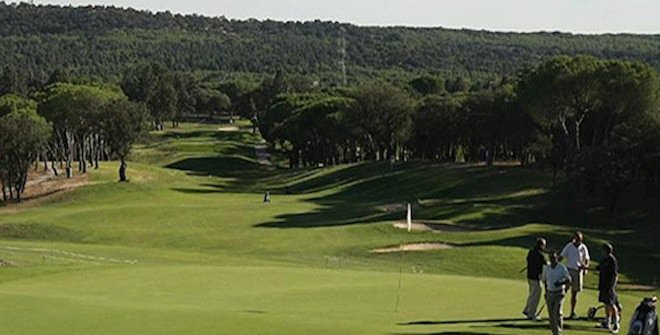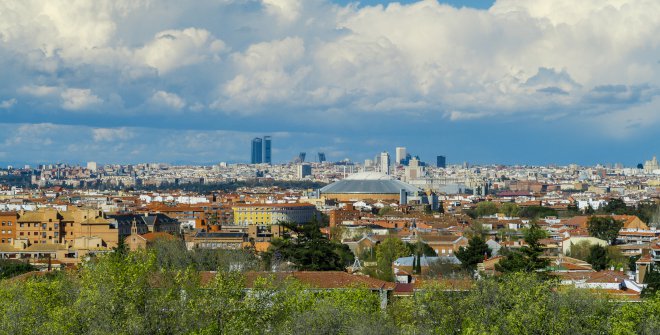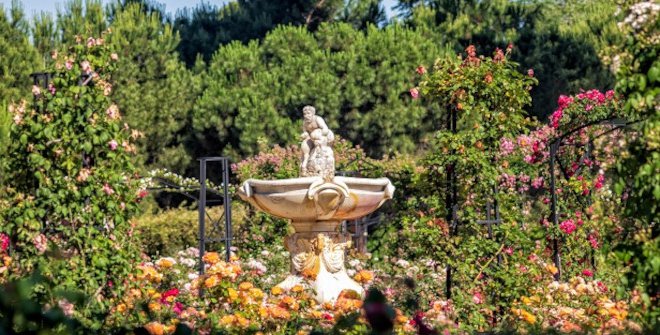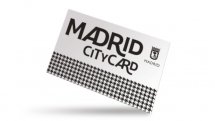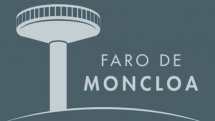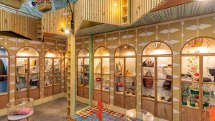Explore Ciudad Universitaria
The neighbourhood of Ciudad Universitaria, in the district of Moncloa-Aravaca, is home to two of the most important universities in Madrid, La Universidad Complutense and La Universidad Politécnica de Madrid. In addition, it has been classed as a historical cultural heritage site since 1999. An area full of nature where you will find university faculty buildings, student halls of residence and colleges, with sports areas, a botanical garden, fascinating museums and the Faro de Moncloa Tower.
Located on the outskirts of the city, but only 20 minutes by metro from the Puerta del Sol (stations Ciudad Universitaria -L6-, Moncloa -L3 and L6-, Vicente Aleixandre -L6-, Guzmán el Bueno -L6 and L7- and Francos Rodríguez -L7-), this is Madrid’s student area, with faculty buildings, colleges and student halls of residence, whilst also being one of the city’s green lungs.
Construction work began in 1929, seeking to emulate American-style campuses, and the first phase was completed before the Civil War with the Hospital Clínico San Carlos, the Faculties of Medicine, Pharmacy and Dentistry, the Science area with the Faculties of Chemistry, Physics and Mathematics, the Humanities area with the Faculties of Philosophy and Law, and the Arts area. After the war (which left the area badly damaged), work resumed with the construction of the rest of the faculties and a series of colleges for students.
Large green areas
Of course, you will see plenty of students in this area, but Ciudad Universitaria is also frequented by other local residents of all ages thanks to its many green areas to practice sports, walk or simply disconnect in the heart of nature.
The Dehesa de la Villa Park is located behind the technical faculties and CIEMAT, a wonderful area of woodland and forest with large pine trees and abundant wild vegetation. It is home to more than 70 species of birds, which makes it a jewel among all the parks of Madrid.
Here you will also find El Cerro de los Locos, formerly known as El Cerro de las Balas, a natural vantage point that offers stunning views of Madrid and its surrounding mountains. Also, just over a kilometre from El Cerro de los Locos, in a bend in the old Dehesa de la Villa road, you can visit another beautiful vantage point with wonderful views to the west of Madrid.
In addition, within the Universidad Complutense de Madrid, between the faculties of Pharmacy and Biology, is the Complutense Botanical Garden, whose official name is the Alfonso XIII Royal Botanical Garden. A space dedicated to botanical knowledge, teaching and research, which covers an area of 50,000 m² and has more than 800 botanical species. It frequently hosts music events, such as the Noches del Botánico festival, and other types of activities such as themed markets or Christmas shows.
Next to this neighbourhood is the park known as Parque del Oeste. Covering an area of approximately 100 hectares, it is well worth getting lost as you wander its pathways until you find the three bunkers for machine guns, which bear witness to how badly this area was hit by the Civil War (very close is the famous Puente de los Franceses bridge). Take a stroll along the path that runs alongside its beautiful stream, soak up the sun by its lake, or visit the many statues that pay tribute to the liberators of South America (Bolívar, Artigas, San Martín ...).
Places of interest
The Ciudad Universitaria neighbourhood is home to eminent academic institutions such as the Complutense University of Madrid, the Polytechnic University of Madrid, and the National Open University (UNED), in addition to other institutions such as the Centre for Energy, Environmental and Technological Research (CIEMAT), the RTVE Institute... and the presidential palace of La Moncloa, but one truly unmissable site is the Faro de Moncloa tower.
Take a ride up this 110-meter-high tower in its spectacular panoramic elevator. Built in 1992, the tower has a large viewing platform that offers panoramic views of the Royal Palace, the Almudena Cathedral, the Telefónica building on Gran Vía, the Cuatro Torres Business Area, and even the peaks of the distant Sierra de Guadarrama.
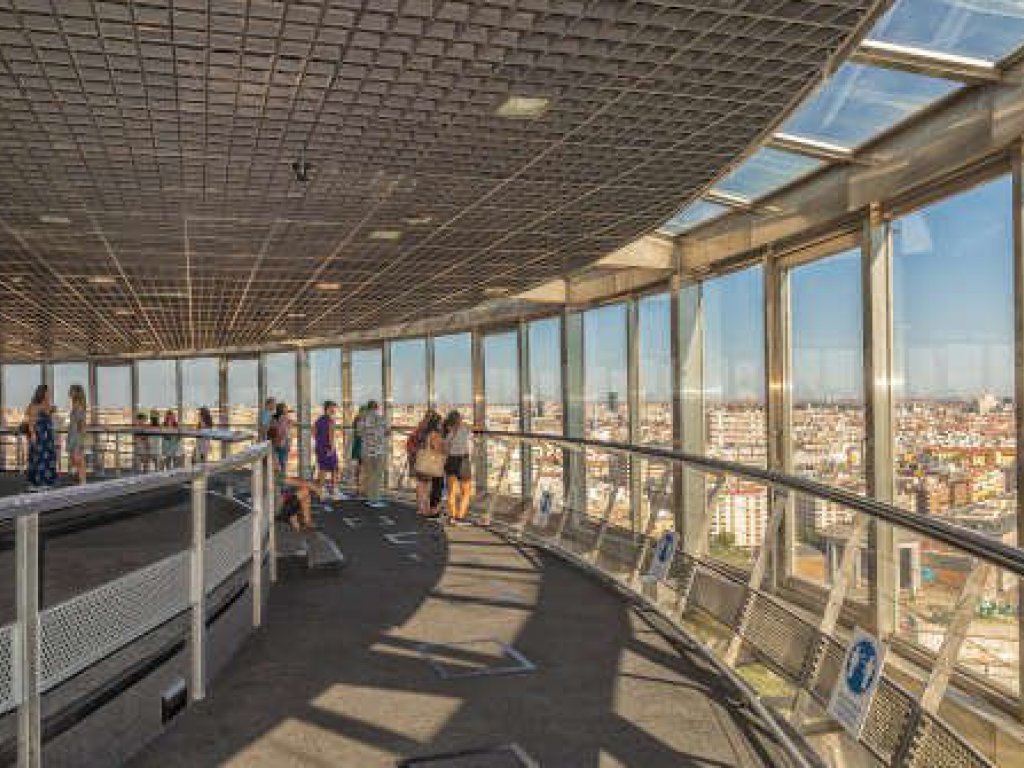
One of the hidden secrets of Ciudad Universitaria is more than 600 years old: the door of the old Hospital de la Latina, an important example of late Gothic architecture, which was installed in 1959 on the outside of Madrid’s School of Architecture. You will also be amazed by the Spanish Cultural Heritage Institute, one of the most significant works of contemporary Spanish architecture, also known as the Crown of Thorns.
The Ciudad Universitaria Thermal Power Station is also very interesting. Built in 1932 by the architect Manuel Sánchez Arcas and the engineer Eduardo Torroja Miret, it is an architectural gem of the rationalist style awarded the National Architecture Prize that same year, which aimed to generate thermal energy for the buildings in Ciudad Universitaria, a pioneering example of the use of central heating.
Museums and cultural spaces
By the Faro de Moncloa Tower, you can also visit the Museum of the Americas, an institution dedicated to the conservation, research and dissemination of heritage from the Americas and the cultures that have inhabited the continents throughout history. Founded in 1941, its collections are extensive and diverse and contain more than 25 000 pre-Hispanic archaeological objects, works of art from the vice-royalty period and a large ethnographic sample of American cultures of the 19th and 20th centuries.
On the Avenida de Juan de Herrera, you can find the The Garment Museum (Ethnological Heritage Research Centre). It contains a wide variety of historical and contemporary collections including examples of 18th century men's clothing, a large collection of jackets and waistcoats, as well as a collection of women's jackets and traditional majismo garments. It also houses a section dedicated to traditional clothing, with an extensive collection of regional costumes. In addition, on the ground floor of this museum is the Complutense Art Centre, better known as C Arte C, a museum space that platforms new artistic trends.
First opened in 1928, Casa de Velázquez, located at No. 3 Calle de Paul Guinard, is a French institution that seeks to promote cooperation and artistic, cultural and university exchanges bilaterally and internationally. Its activities support contemporary artistic creation and scientific research in the field of Human and Social Sciences.
The Faculty of Mathematics at the Complutense houses the Museum of Astronomy and Geodesy with an extensive collection of Astronomical, Geodesic and Topographic instruments. At this educational centre, you can learn more about the evolution of the methods used in these disciplines over the last 150 years.
You can also visit (prior booking required) the interesting INEF Museum, which has a series of historical collections of material, equipment and various pieces concerning physical activity, sport and play.
Sports facilities
On the Complutense University Campus you’ll find the Zona Sur Sports Complex, the Zona Norte Complex (Auditorium), the Zone Suroeste Sports Complex (Cantarranas) and the Nuestra Señora de la Almudena Sports Complex (with indoor pool and indoor sports pavilion).
The first has sports courts, tennis courts, paddle tennis and beach volleyball, indoor frontón court, gym, a 300-metre athletics dirt track, outdoor exercise equipment, climbing wall and the Complutense National Rugby Stadium, also known as the Central Campus of Ciudad Universitaria or simply Central. This stadium is usually used by the Spanish rugby team for international competitions as the largest rugby stadium in Spain. It also has one of the most popular swimming pools in the city (it only opens during the summer and only allows students and teachers to enter, both from the Complutense and from any other university).

The Zona Norte complex has football and rugby fields, sports courts and tennis and paddle courts and hosts lively matches between university league teams.
In the area there is also the Puerta de Hierro Sports Park, a large sports complex with a huge summer pool and a beautiful path that leads to Monte de El Pardo along the Manzanares River, and El Quijote Municipal Sports Centre with facilities spread over 11,500 m² that include four paddle tennis courts (glass walls), a summer pool, two multipurpose rooms and a weights room.
This neighbourhood is also home to La Zarzuela Race Track and two prestigious golf clubs: The Club de Campo Villa de Madrid (home of the Spanish Acciona Open) and the Real Club de la Puerta de Hierro.
Eating out
The best option if you’re looking to grab a bite to eat in this area would be the cafés and restaurants of the faculty buildings, which are usually very reasonably priced (especially recommended is the terrace inside the Zona Sur Sports Complex).
If you’re looking for something a little more upmarket, head to the Café de Oriente at the Museum of Clothing, which has a coffee shop open from Tuesday to Sunday and a restaurant, open on Friday evenings and Saturdays for lunch and dinner.
The area of Dehesa de la Villa has two very interesting terraces/restaurants: El Ancla II and La Paloma, two former kiosks that have recently been reopened. The perfect spots to recharge your batteries after hiking up the steep slopes of La Dehesa.
Other proposals are the Restaurante Sal Gorda (near the colleges), or, between Guzmán el Bueno and Cuatro Caminos, the restaurant Desde 1911, awarded a Michelin star in the 2024 edition of the prestigious guide.
